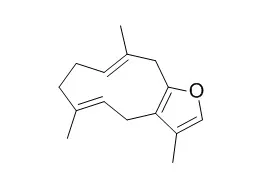| In vitro: |
| Cell Physiol Biochem. 2012;30(3):778-90. | | Furanodiene, a natural product, inhibits breast cancer growth both in vitro and in vivo.[Pubmed: 22854281] | Previous studies have reported that the Curcuma wenyujin Y.H. Chen et C. Ling extract, which has a high Furanodiene content, showed anti-cancer effects in breast cancer cells in vitro. The present study was designed to evaluate the in vitro and in vivo anti-cancer activity of Furanodiene.
METHODS AND RESULTS:
The in vitro effects of Furanodiene were examined on two human breast cancer cell lines, MCF-7 and MDA-MB-231 cells. Assays of proliferation, LDH release, mitochondrial membrane potential (ΔΨm), cell cycle distribution, apoptosis and relevant signaling pathways were performed. The in vivo effect was determined with MCF7 tumor xenograft model in nude mice. Furanodiene significantly inhibited the proliferation and increased the LDH release in both cell lines in a dose-dependent manner. ΔΨm depolarization, chromatin condensation, and DNA fragmentation were also observed after Furanodiene treatment. Furanodiene dose-dependently induced cell cycle arrest at the G0/G1 phase. The protein expressions of p-cyclin D1, total cyclin D1, p-CDK2, total CDK2, p-Rb, total Rb, Bcl-xL, and Akt were significantly inhibited by Furanodiene, whereas the protein expressions of Bad and Bax, and the proteolytic cleavage of caspase-9, caspase-7, and poly-ADP-ribose polymerase (PARP) were dramatically increased. Furthermore, the z-VAD-fmk markedly reversed the Furanodiene-induced cell cytotoxicity, the proteolytic cleavage of caspase-9, and DNA fragmentation but did not affect the proteolytic cleavage of PARP, whereas the Akt inhibitor VIII increased the Furanodiene-induced cytotoxicity and PARP cleavage. In addition, Furanodiene dose-dependently suppressed the tumor growth in vivo, achieving 32% and 54% inhibition rates after intraperitoneal injection of 15 mg/kg and 30 mg/kg, respectively.
CONCLUSIONS:
Taken together, we concluded that Furanodiene suppresses breast cancer cell growth both in vitro and in vivo and could be a new lead compound for breast cancer chemotherapy. | | Mem Inst Oswaldo Cruz. 2015 Feb;110(1):106-13. | | Therapeutic switching: from antidermatophytic essential oils to new leishmanicidal products.[Pubmed: 25742270 ] | This study examined whether the antidermatophytic activity of essential oils (EOs) can be used as an indicator for the discovery of active natural products against Leishmania amazonensis.
The aerial parts of seven plants were hydrodistilled.
METHODS AND RESULTS:
Using broth microdilution techniques, the obtained EOs were tested against three strains of dermatophytes (Trichophyton mentagrophytes, Microsporum gypseum and Microsporum canis). To compare the EOs antifungal and antiparasitic effects, the EOs activities against axenic amastigotes of L. amazonensis were concurrently evaluated. For the most promising EOs, their antileishmanial activities against parasites infecting peritoneal macrophages of BALB/c mice were measured. The most interesting antifungal candidates were the EOs from Cymbopogon citratus, Otacanthus azureus and Protium heptaphyllum, whereas O. azureus, Piper hispidum and P. heptaphyllum EOs exhibited the lowest 50% inhibitory concentration (IC50) values against axenic amastigotes, thus revealing a certain correspondence between both activities.
The P. hispidum EO was identified as the most promising product in the results from the infected macrophages model (IC50: 4.7 μg/mL, safety index: 8).
CONCLUSIONS:
The most abundant compounds found in this EO were sesquiterpenes, notably curzerene and Furanodiene. Eventually, the evaluation of the antidermatophytic activity of EOs appears to be an efficient method for identifying new potential drugs for the treatment of L. amazonensis. | | Phytother Res. 2014 Feb;28(2):296-9. | | Furanodiene presents synergistic anti-proliferative activity with paclitaxel via altering cell cycle and integrin signaling in 95-D lung cancer cells.[Pubmed: 23554049] | Furanodiene (FUR) is a natural terpenoid isolated from Rhizoma Curcumae, a well-known Chinese medicinal herb that presents anti-proliferative activities in several cancer cell lines. Recently, we found that the combined treatment of FUR with paclitaxel (TAX) showed synergetic anti-proliferative activities in 95-D lung cancer cells.
METHODS AND RESULTS:
Herein, we showed that FUR reduced the cell numbers distributed in mitosis phase induced by TAX while increased those in G1 phase. The protein levels of cyclin D1, cyclin B1, CDK6 and c-Myc were all down-regulated in the group of combined treatment. The dramatically down-regulated expression of integrin β4, focal adhesion kinase and paxillin might partially contribute to the synergic effect.
CONCLUSIONS:
Though FUR alone obviously induced endoplasmic reticulum stress, this signaling pathway may not contribute to the synergetic anti-proliferative effect as the protein expression of CHOP and BIP was similar in FUR alone and combined treatment group. |
|
| In vivo: |
| Nat Prod Res. 2006 Jun;20(7):680-5. | | Anti-inflammatory sesquiterpenes from Curcuma zedoaria.[Pubmed: 16901812] |
METHODS AND RESULTS:
From the methanolic extract of the rhizome of Curcuma zedoaria, we isolated anti-inflammatory sesquiterpene Furanodiene (1) and furanodienone (2) along with new sesquiterpene compound 3 and known eight sesquiterpenes, zederone (4), curzerenone (5), curzeone (6), germacrone (7), 13-hydroxygermacrone (8), dehydrocurdione (9), curcumenone (10), and zedoaronediol (11). Their structures were elucidated on the basis of spectroscopic data. The anti-inflammatory effect of isolated components on 12-O-tetradecanoylphorbol-13-acetate (TPA)-induced inflammation of mouse ears were examined.
CONCLUSIONS:
Compounds 1 and 2 suppressed the TPA-induced inflammation of mouse ears by 75% and 53%, respectively, at a dose of 1.0 micromol. Their activities are comparable to that of indomethacin, the normally used anti-inflammatory agent. |
|






 Cell. 2018 Jan 11;172(1-2):249-261.e12. doi: 10.1016/j.cell.2017.12.019.IF=36.216(2019)
Cell. 2018 Jan 11;172(1-2):249-261.e12. doi: 10.1016/j.cell.2017.12.019.IF=36.216(2019) Cell Metab. 2020 Mar 3;31(3):534-548.e5. doi: 10.1016/j.cmet.2020.01.002.IF=22.415(2019)
Cell Metab. 2020 Mar 3;31(3):534-548.e5. doi: 10.1016/j.cmet.2020.01.002.IF=22.415(2019) Mol Cell. 2017 Nov 16;68(4):673-685.e6. doi: 10.1016/j.molcel.2017.10.022.IF=14.548(2019)
Mol Cell. 2017 Nov 16;68(4):673-685.e6. doi: 10.1016/j.molcel.2017.10.022.IF=14.548(2019)